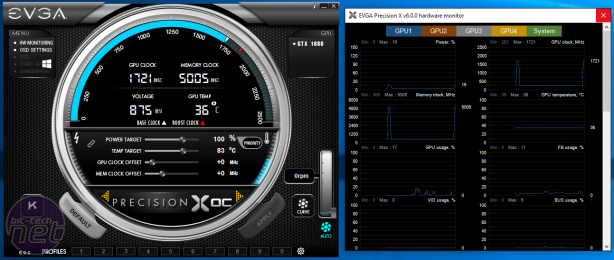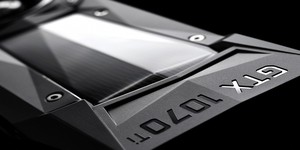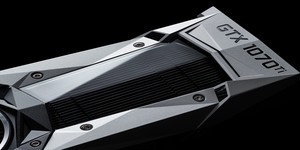EVGA Precision XOC
Precision XOC is EVGA's next-generation PrecisionX software specifically designed for the Pascal architecture. For all Pascal GPUs, including those from rival manufacturers, it offers the usual power target, temperature target, GPU clock and memory frequency adjustments, as well as overclocking profiles, fan control and a wide range of monitoring capabilities. It also supports Pascal's new GPU Boost 3.0 features, namely the ability to set independent voltage/frequency points.However, it is reserving certain features for EVGA GPUs only, such as a DirectX 12 OSD, the OC ScannerX, which automatically attempts to find your optimal voltage/frequency curve, and K-Boost, which forces the card to run constantly at its maximum permitted boost clock to avoid instabilities that arise from sudden drops in voltage, for example. As mentioned, you can also control the FTW card's RGB LED.
EVGA GeForce GTX 1080 FTW 8GB Overclocking
The power limit and temperature limits top out at 120 percent and 92°C with this card. After that, we were able to add 50MHz to the base clock, which gave us a speed of 1,771MHz (boost 1,910MHz) and an actual boost speed of around 1,975MHz constant, after a few initial bursts close to 2GHz. Further stable overclocking wasn't possible, even with voltage increases. This is only a 3 percent base clock increase, or 10 percent compared to reference frequencies, which does seem moderate compared to what the GTX 980 Ti used to manage (often 20-25 percent). Nonetheless, this is our first GTX 1080, and it ships with pretty high speeds to begin with. We'll need to test a few more before we can establish a pattern.As for the memory, we overclocked the new GDDR5X chips by 10 percent, adding 1GHz for a total speed of 11GHz effective. It's crazy to have memory operating this fast; hopefully this is consistent across the chips. A few results from our newly overclocked GTX 1080 FTW are below.
Update 16/06/2016: We're seeing multiple reports here and around the web that people are getting more out of their cards when overclocking than we managed ourselves. Our sample here was one of the first in the world of this SKU (hand-carried back from Computex, in fact) and thus missed out on final validation stages. As such, we are going to be getting a sample of this card in for testing direct from a retailer, thus avoiding any cherry-picking of samples, and redoing our overclocking to see if there's a difference. We will provide further updates with our results as soon as possible.

MSI MPG Velox 100R Chassis Review
October 14 2021 | 15:04










Want to comment? Please log in.